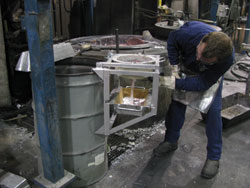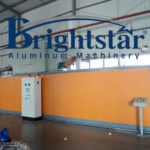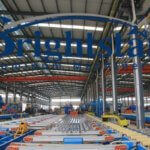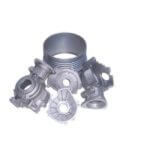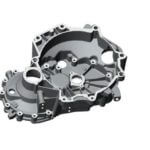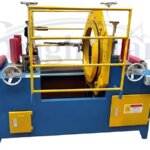Improving aluminum dross recovery for crucible melting
Improving aluminum dross recovery for crucible melting
A specially designed method for transferring untreated, hot dross from the melt surface to a reaction vessel, for convenient recovery.
In-plant aluminum dross recovery has been available for some time, but isn’t widely used for small volumes of dross.
Crucible melting furnaces typically generate 5-25 lb of dross, and most recovery equipment has been considered too cumbersome to move from furnace to furnace.
Many crucible melters stage an empty barrel next to the furnaces as a convenient receptacle for the dross and skims that are the natural products of melting ingot, home returns of gates and risers, and any process degassing or cleansing operations performed on the melt before casting.
The volume of dross generated varies with the charge, but melting losses of 3-8% are common with smaller crucible furnaces.
With the rising cost of alloys, most operations try to reduce the metal content of the drosses they send for recycling. Usually, this involves mixing fluxes with the drosses on the melt surface, manually working the mixtures to separate oxides and dirt from good metal, and then skimming the resulting mix into the barrel.
The task is somewhat obnoxious in that many of the fluxes generate smoke and fumes, and require labor and lost furnace time while cleaning is underway. In spite of these efforts, processed drosses still contain approximately 50% of good alloy, while unprocessed skims and drosses being removed from the crucible furnaces may contain as much as 85-90% good alloy. These co-products of melting are typically removed by local agents for a small portion of the true value of the material.
There is an alternative: Dross Boss TM equipment is specially designed to accept untreated hot dross as it is transferred directly from the melt surface to a Reaction Vessel. There, a small quantity of exothermic flux is added to the mixture of dirt and recoverable metal, and stirred manually or mechanically to encourage gravity separation in the dross mass, with the recovered metal pooling in the bottom of the Reaction Vessel and the remaining dirt and oxides floating on top of the molten alloy. Opening a drain hole in the bottom of the Reaction Vessel, and rotating the frame to spill the demetallized dross into a container, completes recovery.
With the small dross quantities normally produced by crucible melters, a few minutes of manual stirring usually completes the processing and separation. The labor required is approximately equivalent to what is needed to process the dross on the surface of the melter bath. Additionally, with intimate mixing in the Reaction Vessel, much smaller quantities of flux are required, and smoke and fumes are reduced by virtue of working with cooler material.
While Dross BossTM equipment has been used successfully for several years, the equipment available for low volumes melting (e.g., crucible melting) has been a portable two-wheel cart that carries the Reaction Vessel and Ingot Pan from furnace to furnace, where the small batches of dross are processed. Best access to a furnace may be limited, which may lead to some additional effort.
Foundries using Dross BossTM have been impressed with the performance of the Portable Carts, but they suggested a design that could be hung on the collection barrel nearest to the furnace being treated. Thus, the units are directly accessible, and require no maintenance or movement to recover the dross removed.
The recovery results have been impressive, but depend on the nature and analysis of the dross being removed from the furnace. As with other Dross BossTM equipment, the manually stirred units are capable of recovering 60-70% of the alloy contained in the dross. Thus, for an average removal of 10-15 lb of hot dross, operators are typically recovering 6-9 lb. of good alloy per cleaning cycle. Further, the recovered metal has been confirmed to be clean, and of virtually the same analysis as that removed from the furnace.
The only change in chemistry is a small loss of magnesium and strontium, if present. The recovered metal may be returned at elevated temperature directly to the furnace from which the dross was pulled. With melting energy costs running up to $0.05/lb, an additional saving can thus be achieved.
Units are available with both 30- and 60-lb Reaction Vessels, and sized accordingly. Dross BossTM units are in operation for foundries and diecasters, processing hot dross quantities as large as 215 lb. A 300-lb. capacity unit is under construction, and as with all of the systems over 60 lb., will feature powered mixing. Also, fully automatic units are available that will perform all of the process steps after the dross transfer has been made.
From Foundary

